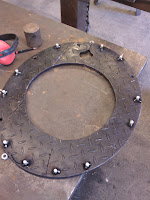One of the things I want to tackle this week is fixing the face into place once and for all. To secure the face it needs to be bolted to the body. The problem I have is that I can not get into the body to tighten the nuts to the bolts.
The only access I have is through the hole in the side of the sculpture, the problem is that I cannot get my hand inside so I have fashioned this tool; spanner, cable ties, pipe. done. By placing a little masking tape into the jaws of the spanner I am able to hold the nut in place without it falling off inside the sculpture.
Now to the side detail. With the face fixed in place I can finally finish off the sculpture, with the last thing being the need to close up the side hole.
To start off this process I have welded steel 'ribs' to the internal frame, my plan is to rivet copper to these ribs so they have been pre-drilled.
Now to fold forming. Using old bits of copper tank and paper templates I have started to cut squares of copper to form what will be 'bandage' detail for the exposed gap in the sculpture.
I'm no expert but fold forming is a fairly straight forward process. Firstly you take sheet copper, and heat it to just about red hot and quench it suddenly in water (anealing). By doing this the metal becomes more pliable and 'soft'. The copper is then folded and hammered. Hammering makes a permanent crease in the metal but makes it rigid again so the anealing process needs to be repeated. My aim is to have two or three folds in each square.
Unfolding the metal reveals the creases. Hopefully the slighlty angular lines will make it read as 'wrappings'. The sheets are then curved so that they will look like there is something within.



















































